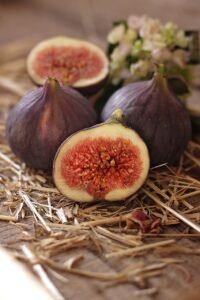Introduction
Fig, an ancient fruit, is believed to have originated from western Asia and spread to other parts of the world through Mediterranean countries. Fig trees, a type of rubber tree, thrive in various climatic conditions, from mid-temperate to tropical and subtropical regions. They thrive in dry weather and light spring rains, but extreme hot and dry spells can result in fruit drop. Fig trees prefer arid or semi-arid environments, light summer temperatures, plenty of sunlight, and moderate water.
They are extremely drought tolerant and prefer sandy soil with a pH of 6–6.5 and a fairly saline environment. Fig trees can tolerate high levels of sulphate and chloride salt. They are propagated by cutting mature wood into ½–2/3 inch (1.25–2 cm) thick and 8–12 in (20–30) long rootstocks, which are planted in the nursery in February.
Morphology
The fig tree, a small bushy tree, grows up to 12 meters tall with numerous branches, smooth grey or white bark, and a trunk rarely more than 7 inches in diameter. It has an aggressive spreading and shallow root system that supports it even in inhospitable environments. The deciduous plant has palmate leaves, fragrant, and copious milky latex. The plant has long-styled female flowers that bear edible fruits, while short-styled female flowers produce inedible fruits. The edible fruit is propagated via insects and is usually pyriform-obovoid, growing up to 2-5 cm in diameter.
The fruit is considered a false fruit, containing hundreds of small fruits called pips. The fruit is an inverted flower with both male and female parts enclosed in stem tissue known as syconium. The fruit can be obovoid, turbinate, or pear-shaped, with lengths ranging from 1-4 inches and colors ranging from yellowish to purple. Juice from the fruit is sweet when ripened, or gummy with latex when unripe.

Nutritional Importance
Fig fruit is mentioned in religious texts like the Bible and Quran, known for its soft, gentle nature. Fresh figs are known for their attractive taste and excellent nutritional composition, including proteins, amino acids, carbohydrates, minerals, vitamins, organic acids, and fibers. Dried figs are often considered the Poor Man’s diet in Mediterranean countries.

Carbohydrates
Fig is a high-carbohydrate fruit with a carbohydrate content of 19.2 g/100 g, with 92% sugars. It contains dietary fiber, insoluble cellulose, and soluble protein. The total sugar content is 16.3 g/100 g, with some varieties having antimicrobial properties.
Proteins
Fig, despite having a lower protein content (0.8 g/100 g), contains the highest number of amino acids among edible fruits, including leucine, tryptophan, phenylalanine, lysine, and histidine, and is rich in proteolytic enzymes.
Fat, Phytochemicals, and organic acids
Figs contain a small amount of fat, but they are rich in lipid compounds, phytochemicals, minerals, vitamins, and organic acids. They contain over 100 bioactive compounds, including arabinose, β-amyrins, β-carotenes, glycosides, β-sitosterol, and xanthotoxol. Figs also contain phenolic compounds, phytosterols, organic acids, anthocyanins, ten terpenoids, coumarins, and volatile compounds. The most prominent phenolic compound is rutin, followed by quercetin rutinoside, catechin, chlorogenic, acid, epicatechin, gallic acid, syringic acid, and ferulic acid.
Minerals
Figs are also rich in iron, calcium, potassium, K, Ca, and Fe levels, and are low in sodium and cholesterol.
Vitamins
Figs are rich in vitamins, including A, B, C, E, and K.
Organic Acid
The fruit is also low in organic acids, with the major ones being oxalic, citric, malic, quinic, shikimic, and fumaric.
Health Benefits

-
Anti-inflammatory effect
-
Antioxidant potential
-
Lowers Blood Pressure
-
Chemo-preventive effect
-
Hypoglycemic effect
-
GI effect
-
Improves Heart Health
Conclusion
Fig is one of the most important fruits due to its rich nutritional composition and health benefits. It protects from various life-threatening diseases.

